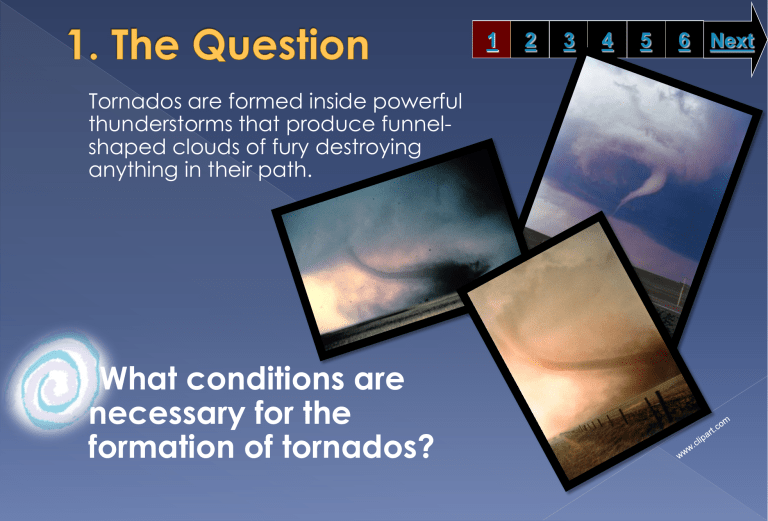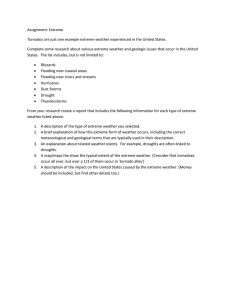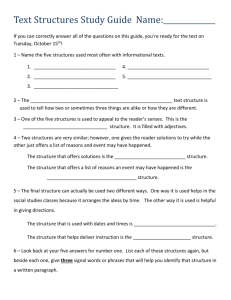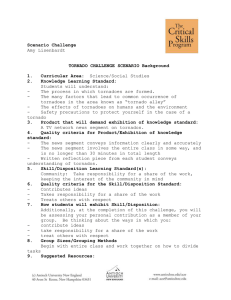Tornados are formed inside powerful thunderstorms that produce funnel-

Tornados are formed inside powerful thunderstorms that produce funnelshaped clouds of fury destroying anything in their path.
What conditions are necessary for the formation of tornados?
You will review the following web resources in order to increase your knowledge of tornados:
All Stars
Tornado Videos
Be sure to ask your teacher which star you are for this activity.
Click on your assigned star.
Courtesy of noaa
You will complete the following activities in order to refine your new learning:
a.
Complete Activity A
b.
Complete Activity B and
Activity C
You will perform the following tasks in order to complete your assessment. a.
b.
Read an article on
Tornado Alley
Complete the
Assessment Activity
Courtesy of noaa
Real World Applications:
Tornados
Statistics and Tornados
Safety and the
Scientific Study of
Tornados
Tornado Preparedness
Teacher Notes:
Objective: Students will be to examine characteristics of tornadoes in order to describe the conditions necessary for their formation.
Differentiation: All students complete the same class work and assessment
.However they are divided into gold and silver stars for reading. Gold stars read the site without any assistance whereas for silver stars the site
Time Management Strategies: It is suggested that this activity This activity could also be conducted in groups of two students.
Technology Infusion: The students will need to be introduced to drop-down menus and entering the text into the enabled areas. Students should also be familiar with opening hyperlinks in both the documents and in the Power point presentation. The students should also be familiar with tabs (sheets in excel), entering text in boxes, clicking into boxes
AVID Strategy: The following AVID strategies are supported in this lesson: inquiry based learning, quick write (reaction and analysis) and use of Costas and
Bloom questioning.
Maryland State Curriculum Goal:
Standard 3.0 Life Science
The students will use scientific skills and processes to explain the dynamic nature of living things, their interactions, and the results from the interactions that occur over time.
Indicator
4
. Interactions of Hydrosphere and Atmosphere #3: Identify and describe the atmospheric and hydrospheric conditions related to weather systems.
Objectives d. Cite features that can be used as evidence to distinguish among the three
Identify and describe weather patterns associated with high and low pressure systems and frontal systems.
e. Identify and describe the atmospheric and hydrospheric conditions associated with the formation and development of hurricanes, tornadoes, and thunderstorms.
Common Core Standards :
Reading Standards for Literacy in Science and
Technical Subjects 6–12
Learning Styles: Field Dependent, Field independent, Visual and Reflective
Learners, Global Understanding
Key Ideas and Details
1. Cite specific textual evidence to support analysis of science and technical texts.
Integration of Knowledge and Ideas
7. Integrate quantitative or technical information expressed in words in a text with a version of that information expressed visually
(e.g., in a flowchart, diagram, model, graph, or table).
Craft and Structure
4. Determine the meaning of symbols, key terms, and other domain-specific words and phrases as they are used in a specific scientific or technical context relevant to grades 6–8 texts and topics.
Range of Reading and Level of Text Complexity
10. By the end of grade 8, read and comprehend science/technical texts in the grades 6–8 text complexity band independently and proficiently.
Last update: May 2011
Created by Keishauna Banks
BCPS Research Module or Slam Dunk Model, Copyright 2005, Baltimore County Public Schools, MD, all rights reserved. The models may be used for educational, non-profit school use only. All other uses, transmissions, and duplications are prohibited unless permission is granted expressly. This lesson is base d on Jamie McKenzie’s Slam Dunk Lesson module available at http://questioning.org/module2/quick.html
.



